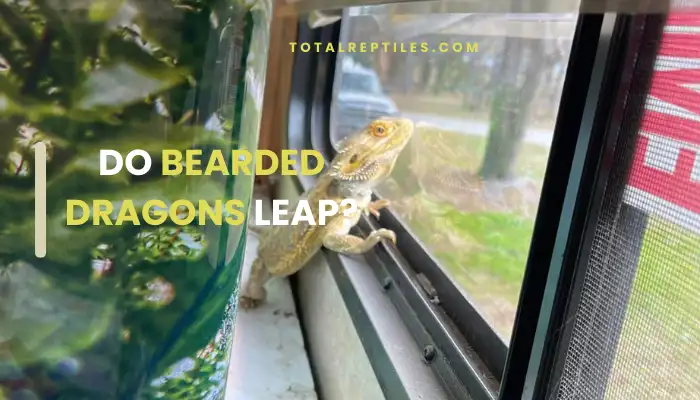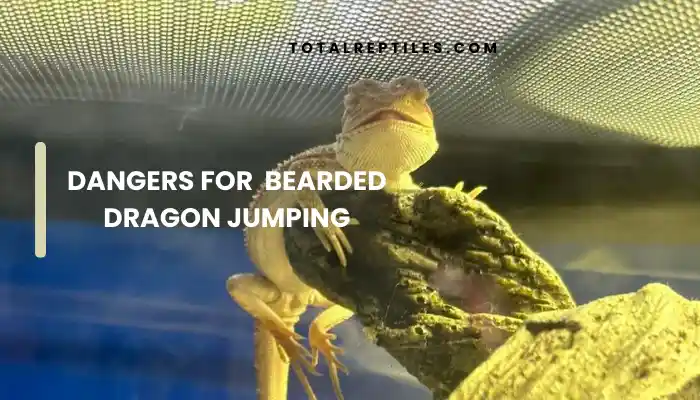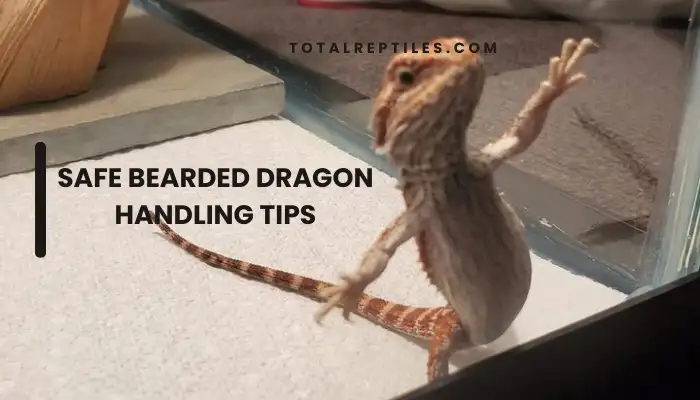Bearded dragons can jump. As reptiles with short legs and stumpy bodies, bearded dragons aren’t built for leaping. They jump from higher to lower places and usually jump when excited, curious, or playful. Some bearded dragons can reach up to 20 inches or 5 feet.
Bearded dragons (Pogona species) are rapidly growing in popularity as pet reptiles. Their calm temperaments and seemingly endless curiosity make them delightful companions. Potential owners often ask: can bearded dragons jump? This question arises from their stocky build and short limbs. Bearded dragons appear better at walking and climbing than explosive leaps. But make no mistake – these lizards can surprise you with sudden bursts of speed and agility when sufficiently motivated.
Continue reading to discover about bearded dragon jump height, strategies, and motivations for jumping. Discover what makes their controlled descent from basking platforms unique compared to leaping mammals.

Jumping and Landing Capabilities of Bearded Dragons
In the wild, bearded dragons inhabit rocky and arid regions of Australia. Jumping serves key functions like navigating terrain, hunting insects, and escaping predators. But how far can bearded dragons jump?
Bearded dragon jump height typically ranges from 8-20 inches. Their jumps are inclined downward rather than vertical. Jumping upwards allows limited lift against gravity without wings or springy legs.
For lower surfaces, bearded dragons use brief airborne pauses and directed plummets. This technique is better characterized as controlled descent rather than pure leaping ability.
Their gravity-defying jumps break the plodding, blinking monotony of their days. Just remember – falls over 3 feet can lead to broken limbs or worse without a soft landing surface. Unwise jumps may occur due to poor depth perception.
So, proper tank setup ensures safe jumping opportunities without deadly consequences. Curiosity overrides caution.
Read more: Do Bearded Dragons Have Feelings?
Do Bearded Dragons Leap? Clarifying Misconceptions
Many new bearded dragon owners wonder – can bearded dragons jump from high places?
But in reality, their stocky bodies and short limbs make them ill-suited for Olympic long jumps or vertical high jumps. Here are the key facts:

Bearded Dragons Don’t Vertically Leap More Than 2 Feet High
Bearded dragons can jump 24 inches from a standstill with forceful leg thrusts. And most completely airborne jumps are less than 12 inches high.
For perspective, house cats can leap 5-7 times their height. So a one-foot-high bearded dragon must reach 6 feet airborne to match a house cat’s relative performance!
Horizontal Jumping Distance is Also Very Limited
Horizontal launches from rocks or branches are better for bearded dragons than vertical high jumps. But they still only achieve short hops of one to two feet in most cases.
Bearded dragons’ airborne motions are best described as “controlled descent” due to their restricted leaping skills. As mentioned, they utilize directed falls at angles rather than vertical ascents. And forward movement is minimal regardless of direction.
Thus, while “jumping” is not wrong, it conjures unrealistic thoughts of forceful leaping. Without landing provisions, a two-foot jump can cause injury.
Reasons Your Bearded Dragon May Jump
Natural jumping behaviour serves key purposes for bearded dragons in the wild. But captivity also introduces unique factors that motivate jumping.
Here are the most common reasons bearded dragons take to the air.
Hunting Feeder Insects
In the wild, bearded dragons jump short horizontal distances to capture scurrying feeder insects and small vertebrates. Their jumps typically range from 6-12 inches.
In a controlled environment, pet bearded dragons may exhibit similar hunting behaviours when chasing feeder insects like dubia roaches or crickets. These short hops help them capture elusive prey.
Escaping Perceived Threats
Bearded dragons jump to escape predators because of their size. In captivity, even harmless stimuli can trigger this escape response. Their jumps are often Angled downwards as they retreat to lower levels away from the perceived menace.
Anything viewed as threatening can trigger escape jumps. But these behaviours may also indicate improper handling or environmental stressors to address.
Navigating Enclosure Features
Bearded dragons inhabit craggy, rocky terrain in the wild. They frequently jump downward from boulders and branches to access lower levels.
Recreating these multi-level environments in captivity encourages natural navigational jumping. Providing climbing branches and elevated basking platforms promotes short jumps up to 12 inches high.
Fledgling Exploratory Jumping
Younger bearded dragons jump more often than adults overall. More developed spatial awareness might be needed to avoid harm from exploratory jumps.
But don’t discourage all jumping in juveniles. Allowing safe avenues helps them build critical environmental assessment abilities, even if awkward mishaps occur.
Stress, Fear, or Neurological Causes
Sudden uncontrolled jumping with no apparent stimulus can indicate underlying health issues.
Many conditions can cause spontaneous jumping, including stress, neurological diseases, and chemical imbalances. Always consult an exotic veterinarian to identify and address potential causes.
Dangers Associated With Bearded Dragon Jumping
Jumping is natural, but uncontrolled jumps can injure captivity. Their limited cushioning and short recovery time in midair means accidents happen fast.

Lack of Suspended Landing Specialization
Mammals like cats utilize body torsion and limb-specific shock absorption when free falling. But bearded dragons lack such specializations for stickying the landing.
They experience the complete shock of impact through their axial skeleton. Broken bones are joints in accidents without padding.
Short Limbs & Minimal Cushioning
Speaking of cushioning – bearded dragons lack any significant protective buffering against falls. Their tough scales and short limbs don’t cushion traumatic impact.
Their heavyset head makes up over a quarter of their body weight. Jumping delivers more momentum to the spine and shoulders.
Metabolic Bone Disease Complications
Metabolic bone disease is unfortunately common in captive specimens. The resulting bone fragility and impaired fracture healing make jumping riskier for affected reptiles.
Even shortfalls can lead to devastating limb and spinal trauma. Always have an exotic veterinarian evaluate bone health in rescued or rehomed bearded dragons.
Limited Midair Recovery Ability
Some mammals can remarkably reorient mid-fall by contorting limbs or using membranes to generate lift. But bearded dragons lack such recovery options once airborne.
They suffer complete gravity-driven falls. Celebrating controlled risks is preferable to reckless jumps.
Read more: Are Bearded Dragons Ticklish?
Encouraging Safe Jumping Through Proper Bearded Dragon Tank Setup
Recreating critical features of their wild habitat in captivity encourages natural jumping behaviours. The key is providing controlled opportunities without exposure to dangerous heights. Here are some tips:
Maintain Jumping Platforms Below Body Length Elevation
Generally, avoid sustained perches over the lizard’s full-length nose-to-tail. Drops over this threshold lead to increased injury risk.
Use platforms, branches, hammocks, and partial conceals at moderate heights to stimulate movement.
Incorporate Angled Jumping Surfaces
Slope ramps or somewhat elevated hideaways connect elevated surfaces instead of sheer vertical fall.
Angled trajectories give bearded dragons more control over jumping distance and direction. Graduated inclines help gauge depths.
Always Provide Adequate Landing Zones
Large landing surfaces must soften downward jumps on ramps or perpendicular platforms. Substrates like reptile-safe mulch or sand allow for soft landings. Avoid sparse carpet or slick tile that can cause slippage.
And leave plenty of floor space around movable décor for manoeuvrability between surfaces.
Monitor Jumping Behavior
Some bearded dragons may feel tempted to test their jumping limits despite their best efforts. Carefully observe jumping habits and never knowingly allow jumps over 24 inches high. Move problem décor closer to the ground and make all landings soft.
Under the right conditions, bearded dragons can jump freely without harm. But what about handling precautions?
Safe Bearded Dragon Handling Tips to Prevent Risky Jumping
Handling mishaps can still lead to injury even if their enclosure meets all safety standards. Sudden moves or loud noises may startle bearded dragons when held. Here are some handling best practices:

Secure Jumping-Prone Lizards Against Your Chest
Transport excited lizards against your upper chest with both hands instead of above ground.
This protects all four limbs against dangerous midair twisting while fully supporting the abdomen and tail.
Avoid Loose Dangling or Gripping by the Tail or Limbs
Never allow bearded dragons unrestrained movement through dangling or tail holding. Refrain from pulling on limbs to prevent joint trauma.
Full supportive cradling encourages calm movements compared to uncomfortable dangling.
Prevent Access to Raised Surfaces When Agitated
Avoid tables, couches, shelves, and other raised surfaces if your bearded dragon is aggressive or anxious.
Calm them fully before granting exploratory privileges to prevent impulsive decisions.
Always Support Jumps from Hands to Lower Levels
Startled lizards may still unexpectedly launch themselves from seemingly safe hands. Allow them to jump while shielding affected areas. Supporting the launched legs and abdomen during landing reduces rolling and damage. Soft landing surfaces are still essential.
With suitable handling precautions, bearded dragons can enjoy safe exploratory time even if they make occasional misjudged jumps.
conclusion
Though limited in vertical leaping ability, bearded dragons can still impress with their controlled jumps and falls. Stocky lizards jump over 8 inches, with a record of 20. They jump for hunting, territorial navigation, curiosity, or perceived dangers.
They can land safely from exhilarating heights because of hindlimb thrust mechanics, rotating forelimb control, and neck bracing.
Still, falls over 2 feet demand serious injury prevention measures. Multi-level tanks, soft substrates, moderate exercise, and handling care can help dedicated owners foster healthy jumping. Replicating their harsh Australian surroundings allows happy captive dragons to hop without the danger of uncontrolled falls.

